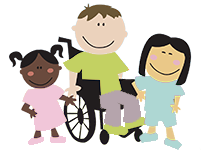Normal Disfluency
Between the ages of two and five, many children pass through periods of disfluency often referred to as stuttering. Repetitions, interjections, revisions, prolongations, and pauses are commonly heard during this stage of language development. When the average child is between two and three-and-a-half, disfluencies reach 10 per 100 words spoken, and may be even greater in some children. Repetitions are probably most common in younger children, while revisions are more frequent in older children. Despite the fact that childhood disfluencies may be occasionally evident to some adults, normally disfluent children seem generally unaware of them in their own speech and consequently have no reactions or secondary behaviors to escape or avoid disfluencies.
Some factors thought to be associated with increases in normal disfluencies include language development, acquisition of speech motor control, interpersonal stress associated with growing up in a typical family, and threats to security from relocation, family breakup, or hospitalization. Disfluencies may also increase under the daily pressure of competition and excitement while speaking.
Normal Disfluencies
Part-word repetition mi-milk
One-syllable word repetition I…..I want that.
Multisyllabic word repetition Lassie…..Lassie is a good dog.
Phrase repetition I want a…. I want a cookie.
Interjection He went to the …uh…circus.
Revision-incomplete phrase I lost my….Where’s Mommy going?
Prolongation I’m Tiiiiimmy Thompson.
Tense Pause Can I have some more (lips together:
No sound coming out) —milk?
Behaviors Associated with Borderline and Beginning Stuttering
More than 10 disfluencies per 100 words
Core Behaviors
Repetitions – usually more than two per word Prolongations
Blocks – Speaker inappropriately stops the flow or air or voice and often the movement of his articulators as well. Blocking may occur at the respiratory, laryngeal, or articulatory level.
Secondary Behaviors
Escape behaviors – Speaker attempts to get out of the stutter and finish a word, for example: eye blinks, head nods, or interjections.
Avoidance behaviors – Anticipates stuttering and attempts to avoid the stutter by changing a word, pausing, or use of an eye blink (which is also an escape behavior).
From Stuttering: An Integrated Approach to Its Nature and Treatment, Peters
If you suspect your child may have a stuttering disorder, contact a speech pathologist who is experienced with disfluency disorders to help determine whether your child needs help
